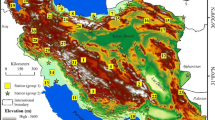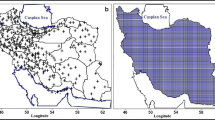Abstract
Climate change is a prevalent issue all around the world. Changes in the temperature and precipitation, as well as their distributions, are the evidence of climate change. Therefore, the objective of this study was to gather and standardize information about temperature (maximum and minimum temperatures and the discrepancy between them) and precipitation in Iran’s environmental zones. The long-term meteorological dataset was gathered from 47 synoptic stations for 66 years (1951–2017). Linear regression was employed to show the type and trend of changes in the studied variables. The Köppen method and UNESCO aridity index were adopted for climate classification based on temperature and precipitation criteria, respectively. Based on the Köppen method, the climate of Iran is defined into 4 environmental zones consisting of the arid desert (Bw), semi-arid (Bs), humid with mild winters (C), and humid with severe winters (D). On the basis of the UNESCO aridity index, the climate of Iran is classified into 5 environmental zones including very dry, dry, semi-dry, humid, and very humid. Results demonstrated that at 42 stations (89% of stations), the slope of the trend line was positive and long-term annual average temperatures of 5 stations (11% of stations) were negative. Furthermore, for precipitation, 11 stations (25% of stations) had positive trend and 33 stations had a negative trend (75% of stations). Finally, it was found that there are significant changes in both temperature and precipitation. On the other hand, an overall increasing trend in temperature and a decreasing trend in precipitation were observed from high-altitude or high-latitude cold areas to low-latitude regions such as costal lines in Iran.


Similar content being viewed by others
References
Abbasi F, Asmari M (2011) Forecasting and assessment of climate change over Iran during future decades using MAGICC-SCENGEN model. Water and Soil 25:70–83
Abtew W, Obeysekera J, Iricanin N (2011) Pan evaporation and potential evapotranspiration trends in South Florida. Hydrol Process 25:958–969
Alcamo J, Moreno JM, Nováky B, Bindi M, Corobov R, Devoy RJN, Giannakopoulos C, Martin E, Olesen JE, Shvidenko A (2007) Europe. In: Parry ML, Canziani OF, Palutikof JP, van der Linden PJ, Hanson CE (eds) Climate change 2007: impacts, adaptation, and vulnerability. Contribution of Working Group II to the Fourth Assessment Report of the Intergovernmental Panel on Climate Change. Cambridge University Press, Cambridge, pp 541–580
Aparecido L, Rolim G, Richetti J, De Souza P, Johann JA (2016) Köppen, Thornthwaite and Camargo climate classifications for climatic zoning in the state of Paraná, Brazil. Ciência e Agrotecnologia 40(4):405–417. https://doi.org/10.1590/1413-70542016404003916
Bobee B, Ashkar F (1991) The gamma family and derived distribution applied in hydrology. Water Resources Pub, USA
Dastorani MT, Massah Bavani AR, Poormohammadi S, Rahimian SH (2011) Assessment of potential climate change impacts on drought indicators (case study: Yazd Station, Central Iran). Desert 16:159–167
Dehghani sanij H, Yamamoto T, Rasiah V (2004) Assessment of evapotranspiration estimation models for use in semi-arid environments. Agric Water Manag 64:91–106
Demetracopoulos AC (1994) Nonlinear regression applied to hydrologic data. J Irrigation Drainage Eng-ASCE 120(3):652–659
Dinpajooh Y (2006) Study of reference crop evapotranspiration in I.R. of Iran. Agric Water Manag 84:123–129
Ficklin DL, Abatzoglou JT, Robeson S, Dufficy A (2016) The influence of climate model biases on projections of aridity and drought. J Clim 29:1269–1285. https://doi.org/10.1175/JCLI-D-15-0439.1
Ficklin DL, Maxwell JT, Letsinger SL, Gholizadeh H (2015) A climatic deconstruction of recent drought trends in the United States. Environ Res 11:1–10. https://doi.org/10.1088/1748-9326/10/4/044009
Ghahraman B, Shirgholami H (2008) Investigation of trend slope in mean annual temperature of Iran. J Sci Technol Agricult Environ 9(1):9–23
Gholipoor M (2008) Evaluating the effect of crop residue on water relations of rainfed chickpea in Maragheh, Iran, using simulation. International meeting on soil fertility, land management and agroclimatology, Turkey
Hansen J, Sato M, Ruedy R, Nazarenko L, Lacis A, Schmidt GA, Russell G, Aleinov I, Bauer M, Bauer S, Bell N, Cairns B, Canuto V, Chandler M, Cheng Y, Del Genio A, Faluvegi G, Fleming E, Friend A, Hall T, Jackman C, Kelley M, Kiang N, Koch D, Lean I, Lerner J, Lo K, Menon S, Miller R, Minnis P, Novakov T, Oinas V, Perlwitz J, Perlwitz J, Rind D, Romanou A, Shindell D, Stone P, Sun S, Tausnev N, Thresher D, Wielicki B, Wong T, Yao M, Zhang S (2005) Efficacy of climate forcings. J Geophys Res 110:1–45. https://doi.org/10.1029/2005JD005776
IPCC. Climate Change (2013) Working group I contribution to the IPCC fifth assessment report, 2013. The Physical Science Basis: Summary for Policymakers
Jiao L, Wang D (2018) Climate change, the evaporation paradox, and their effects on streamflow in Lijiang watershed. Pol J Environ Stud 27(6):2585–2591
Jongman RHG, Bunce RGH, Metzger MJ, Mücher CA, Howard DC, Mateus VL (2006) Objectives and application of a statistical environmental stratification of Europe. Landsc Ecol 21:409–419. https://doi.org/10.1007/s10980-005-6428-0
Kjellström E (2004) Recent and future signatures of climate change in Europe. Ambio 33:193–198
Lutgens FK, Tarbuck EJ (2013) The atmosphere: an introduction to meteorology. Pearson Press, USA, pp 378–407 ISBN-13: 978-0-321-75631-2
Mavromatis T, Stathis D (2011) Response of the water balance in Greece to temperature and precipitation trends. Theor Appl Climatol 104(1–2):13–24
Metzger MJ, Bunce RGH, Jongman RHG, Mücher CA, Watkins JW (2005) A climatic stratification of Europe. Glob Ecol Biogeogr 14:549–563. https://doi.org/10.1111/j.1466-822x.2005.00190.x
Mohammadi AH, Belandria V, Richon D (2010) Use of an artificial neural network algorithm to predict hydrate dissociation conditions for hydrogen+water and hydrogen+tetra-n-butyl ammonium bromide+water systems. Chem Eng Sci 65(14):4302–4305. https://doi.org/10.1016/j.ces.2010.04.026
Olesen JE, Bindi M (2002) Consequences of climate change for European agricultural productivity, land use and policy. Eur J Agron 16:239–262
Rafi Sharif Abad J, Nohegar A, Zehtabian G, Khosravi H, Gholami H (2016) Study of desertification status based on a sub-IMDPA model for a case study in Yazd-Ardakan plain, Iran. International Journa Forest Soil Erosion 6(3):73–81
Rahimi Khoob A (2008) Artificial neural network estimation of reference evapotranspiration from pan evaporation in a semi-arid environment. Irrig Sci 27:35–39
Remrov M, Cislerov M (2010) Analysis of climate change effects on evapotranspiration in the watershed Uhlířská in the Jizera mountains. Soil Water Res 5(1):28–38
Saboohi R, Soltani S, Khodagholi M (2012) Trend analysis of temperature parameters in Iran. Theor Appl Climatol 109(3–4):529–547
Sabziparvar A (2008) A simple formula for estimating global solar radiation in central arid deserts of Iran. J Renew Energy 33(5):1002–1010
Salajegheh A, Rafiei Sardooei E, Moghaddamnia A, Malekian A, Araghinejad S, Khalighi Sigaroodi S, Salehpour Jam A (2016) Prediction of climatic variables using statistical downscaling model (SDSM) in Future under Scenario A2. Desert Manag 4:12–25
Salas JD (1993) Analysis and modeling of hydrologic time series. In: Maidment DR (ed) Handbook of hydrology. McGraw-Hill, Inc., USA, pp 19.1–19.72
Salehpour Jam A, Karimpour Reihan M, Mohseni Saravi M, Bazrafshan J, Khalighi Sigaroudi S (2017) Investigation of climate change effect on drought characteristics in the future period using the HadCM3 model (case study: Khoy station, northwest of Iran). Desert 22(1):43–50
Salehpour Jam A, Mohseni Saravi M, Bazrafshan J, Khalighi Sigaroudi S (2015) Investigation of climate change effect on drought characteristics in the future period using the HadCM3 model, case study: northwest of Iran. J Range Watershed Manag 67:537–545
Shan N, Shi Z, Yang X, Gao J, Cai D (2015) Spatiotemporal trends of reference evapotranspiration and its driving factors in the Beijing-Tianjin Sand Source Control Project Region, China. Agric For Meteorol 200:322–333
Sharafi S, Ramroudi M, Nassiri M, Galavi M, Kamali G (2016) Role of early warning systems for sustainable agriculture in Iran. Arab J Geosci 9:734–754
Sharafi S, Ramroudi M, Nassiri M, Galavi M, Kamali G (2017) Assessment of moisture status and crop production in different climates of Iran. J Agricult KnowledgeSustain Product 7(1):103–120
Soltani A, Sinclair TR (2012) Modeling physiology of crop development, growth and yield. CABI publication, 322p
Szalai S, Szinell C, Zoboki J (2000) Drought monitoring in Hungary. In: Early warning systems for drought preparedness and drought management. WMO, Geneva, pp 161–176
Tabari H, Somee BS, Zadeh MR (2011) Testing for long-term trends in climatic variables in Iran. Atmos Res 100(1):132–140
Von Storch H (1995) Inconsistencies at the interface of climate impact studies and global climate research. Meteorology Z 4(2):72–80
Yue S, Pilon P, Phinney B, Cavadias G (2002) The influence of autocorrelation on the ability to detect trend in hydrological series. Hydrol Process 16(9):1807–1829
Zhang H, Sun J, Xiong J (2017) Spatial-temporal patterns and controls of evapotranspiration across the Tibetan plateau (2000–2012). Adv Meteorol 2017:1–12. https://doi.org/10.1155/2017/7082606
Author information
Authors and Affiliations
Corresponding author
Additional information
Responsible Editor: Haroun Chenchouni
Rights and permissions
About this article
Cite this article
Sharafi, S., Mir Karim, N. Investigating trend changes of annual mean temperature and precipitation in Iran. Arab J Geosci 13, 759 (2020). https://doi.org/10.1007/s12517-020-05695-y
Received:
Accepted:
Published:
DOI: https://doi.org/10.1007/s12517-020-05695-y




